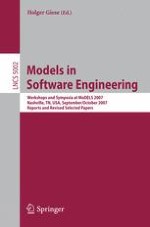This book constitutes the thoroughly refereed post-workshop proceedings of 10 internationl workshops and 2 symposia held as satellite events of the 10th International Conference on Model Driven Engineering Languages and Systems, MoDELS 2007, in Nashville, TN, USA, in September/October 2007 (see LNCS 4735). The 29 revised full papers were carefully selected for inclusion in the book and are presented along with a doctoral and an educators' symposium section. The papers are organized in topical sections representing the various workshops: aspect-oriented modeling (AOM 2007), language engineering (ATEM2007), model driven development of advanced user interfaces (MDDAUI 2007), model size metrics (MSM 2007), model-based design of trustworthy health information systems (MOTHIS 2007), model-driven engineering, verification and validation (MoDeVVa 2007), modelling systems with OCL (Ocl4All 2007), Models@run.time, multi-paradigm modeling: concepts and tools (MPM 2007), quality in modeling, doctoral symposium, and educators' symposium.
